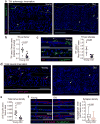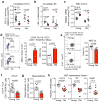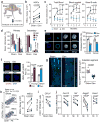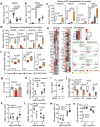Adrenergic nerve degeneration in bone marrow drives aging of the hematopoietic stem cell niche
- PMID: 29736022
- PMCID: PMC6095812
- DOI: 10.1038/s41591-018-0030-x
Adrenergic nerve degeneration in bone marrow drives aging of the hematopoietic stem cell niche
Erratum in
-
Author Correction: Adrenergic nerve degeneration in bone marrow drives aging of the hematopoietic stem cell niche.Nat Med. 2019 Apr;25(4):701. doi: 10.1038/s41591-019-0425-3. Nat Med. 2019. PMID: 30903101 Free PMC article.
Abstract
Aging of hematopoietic stem cells (HSCs) is associated with a decline in their regenerative capacity and multilineage differentiation potential, contributing to the development of blood disorders. The bone marrow microenvironment has recently been suggested to influence HSC aging, but the underlying mechanisms remain largely unknown. Here we show that HSC aging critically depends on bone marrow innervation by the sympathetic nervous system (SNS), as loss of SNS nerves or adrenoreceptor β3 signaling in the bone marrow microenvironment of young mice led to premature HSC aging, as evidenced by appearance of HSC phenotypes reminiscent of physiological aging. Strikingly, supplementation of a sympathomimetic acting selectively on adrenoreceptor β3 to old mice significantly rejuvenated the in vivo function of aged HSCs, suggesting that the preservation or restitution of bone marrow SNS innervation during aging may hold the potential for new HSC rejuvenation strategies.
Conflict of interest statement
The authors declare no competing financial interests.
Figures





Similar articles
-
Neuropathy of haematopoietic stem cell niche is essential for myeloproliferative neoplasms.Nature. 2014 Aug 7;512(7512):78-81. doi: 10.1038/nature13383. Epub 2014 Jun 22. Nature. 2014. PMID: 25043017
-
Harnessing matrix stiffness to engineer a bone marrow niche for hematopoietic stem cell rejuvenation.Cell Stem Cell. 2023 Apr 6;30(4):378-395.e8. doi: 10.1016/j.stem.2023.03.005. Cell Stem Cell. 2023. PMID: 37028404
-
Limited rejuvenation of aged hematopoietic stem cells in young bone marrow niche.J Exp Med. 2021 Mar 1;218(3):e20192283. doi: 10.1084/jem.20192283. J Exp Med. 2021. PMID: 33231616 Free PMC article.
-
Inflammation and Aging of Hematopoietic Stem Cells in Their Niche.Cells. 2021 Jul 21;10(8):1849. doi: 10.3390/cells10081849. Cells. 2021. PMID: 34440618 Free PMC article. Review.
-
Mechanisms and rejuvenation strategies for aged hematopoietic stem cells.J Hematol Oncol. 2020 Apr 6;13(1):31. doi: 10.1186/s13045-020-00864-8. J Hematol Oncol. 2020. PMID: 32252797 Free PMC article. Review.
Cited by
-
Profound sympathetic neuropathy in the bone marrow of patients with acute myeloid leukemia.Leukemia. 2024 Feb;38(2):393-397. doi: 10.1038/s41375-023-02104-7. Epub 2023 Dec 8. Leukemia. 2024. PMID: 38066329 Free PMC article. No abstract available.
-
Optogenetic activation of local colonic sympathetic innervations attenuates colitis by limiting immune cell extravasation.Immunity. 2021 May 11;54(5):1022-1036.e8. doi: 10.1016/j.immuni.2021.04.007. Epub 2021 Apr 30. Immunity. 2021. PMID: 33932356 Free PMC article.
-
Bone marrow niches for hematopoietic stem cells.Hemasphere. 2024 Jul 31;8(8):e133. doi: 10.1002/hem3.133. eCollection 2024 Aug. Hemasphere. 2024. PMID: 39086665 Free PMC article. Review.
-
Niches for Skeletal Stem Cells of Mesenchymal Origin.Front Cell Dev Biol. 2020 Jul 10;8:592. doi: 10.3389/fcell.2020.00592. eCollection 2020. Front Cell Dev Biol. 2020. PMID: 32754592 Free PMC article. Review.
-
Sensory nerve niche regulates mesenchymal stem cell homeostasis via FGF/mTOR/autophagy axis.Nat Commun. 2023 Jan 20;14(1):344. doi: 10.1038/s41467-023-35977-4. Nat Commun. 2023. PMID: 36670126 Free PMC article.
References
Publication types
MeSH terms
Substances
Grants and funding
LinkOut - more resources
Full Text Sources
Other Literature Sources
Medical
Molecular Biology Databases

